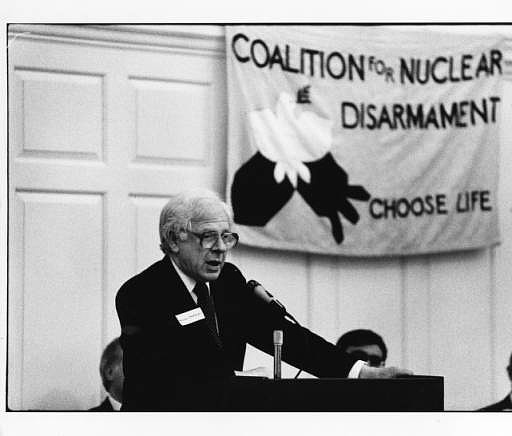Marvin L. Goldberger 1922–2014

Marvin L. “Murph” Goldberger, who served as the Institute for Advanced Study’s sixth Director from 1987–91, died on November 26 at the age of 92. A prominent physicist with a distinguished career in higher education, he was most recently a Professor of Physics at the University of California, San Diego. Before his Directorship at the Institute, Goldberger served as President of the California Institute of Technology from 1978–87.
During his tenure as Director at the Institute, Goldberger created positive growth and change for the institution through Faculty appointments and campus building projects, among other initiatives. Goldberger believed deeply in the Institute’s mission, and observed in 1990, “On balance, a modern-day Flexner, provided he or she were smart enough, wouldn’t go too far wrong to reinvent the Institute largely unchanged in overall form…a truly civilized society should be prepared to support the highest form of pure intellectual endeavor without regard for immediate practical applications.”
Edward Witten, Charles Simonyi Professor in the School of Natural Sciences, who was appointed to the Institute by Goldberger, noted, “Murph was an extremely eminent physicist who made celebrated contributions to pion physics, dispersion relations, and scattering theory. At a personal level, he was an important mentor to me. When I came to Princeton as a graduate student, his quantum mechanics course was one of the first courses I took, and I learned a lot from him through my graduate school days and afterwards. Murph was also highly distinguished as a national leader in science policy.”
Goldberger worked with the Schools to appoint two new Faculty members in addition to Witten during his tenure: Frank Wilczek, now Herman Feshbach Professor of Physics at the Massachusetts Institute of Technology, and Oleg Grabar in the School of Historical Studies, who served from 1990 until his death in 2011. Additionally, to address space needs for the campus community, Goldberger commissioned César Pelli Architects to design a building to house the School of Mathematics, as well as a new auditorium for public lectures and concerts. These buildings, which opened in 1993 and are now known as Simonyi Hall and Wolfensohn Hall, are integral parts of the campus that foster collaboration and help make the Institute a uniquely productive intellectual environment.
Goldberger, born in 1922 in Chicago, earned his B.S. at the Carnegie Institute of Technology (Carnegie Mellon University) and Ph.D. from the University of Chicago. While serving in the Army shortly after graduation, he was assigned to the Manhattan Project, where he worked under renowned physicist Enrico Fermi from 1943–45. Goldberger’s association with the Institute dates back to 1953, while he was on leave from the University of Chicago at Princeton University. He interacted regularly with Institute Director J. Robert Oppenheimer (1947–66) and other physicists with whom he collaborated at the Institute, and eventually came as a Member (1966–70,1976–77) in the School of Natural Sciences. Throughout this time, Goldberger was a Professor of Physics at Princeton University from 1957–78.
Goldberger helped to guide U.S. science policy in the 1960s, and served as a member of the President’s Science Advisory Committee from 1965–69 and was a consultant to the Department of Defense. A recipient of the Dannie Heineman Prize for Mathematical Physics, Goldberger was a member of the National Academy of Sciences, the American Academy of Arts and Sciences, the American Association for the Advancement of Science and the American Philosophical Society.
Goldberger was predeceased by his wife, Mildred Goldberger, in 2006. He is survived by his sons, Joel and Sam, and three granddaughters.
About the Institute for Advanced Study
The Institute for Advanced Study is one of the world’s leading centers for theoretical research and intellectual inquiry. The Institute exists to encourage and support curiosity-driven research in the sciences and humanities—the original, often speculative thinking that produces advances in knowledge that change the way we understand the world. Work at the Institute takes place in four Schools: Historical Studies, Mathematics, Natural Sciences and Social Science. It provides for the mentoring of scholars by a permanent Faculty of approximately 30, and it ensures the freedom to undertake research that will make significant contributions in any of the broad range of fields in the sciences and humanities studied at the Institute.
The Institute, founded in 1930, is a private, independent academic institution located in Princeton, New Jersey. Its more than 6,000 former Members hold positions of intellectual and scientific leadership throughout the academic world. Thirty-three Nobel Laureates and 40 out of 56 Fields Medalists, as well as many winners of the Wolf and MacArthur prizes, have been affiliated with the Institute.